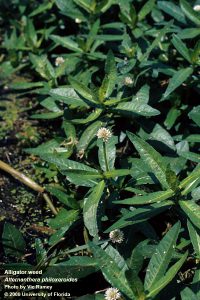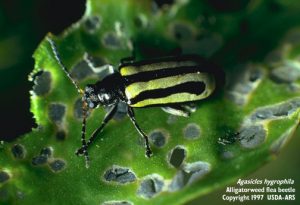Alligatorweed (Alternanthera philoxeroides) is a common pest in Florida that has plagued our state for well over 100 years. Native to Brazil, Paraguay, Argentina, and Uruguay, this plant was accidentally introduced to the Florida gulf coast in 1894 from ship ballast water. Along with water hyacinth (Eichornia crassipes) it was one of the original invaders of Florida and today is vouchered in almost every county. It has further naturalized throughout the South and mid-Atlantic regions and as far north as Illinois.

Alligatorweed prefers to establish along lake shorelines by rooting in the soft sediment. Its stems are hollow and will float. This allows the plant to aggressively expand across the top of the water where it helps facilitate the formation of floating tussocks. This quickly degrades native habitats and can severely impede access and navigation. Management of this plant is often essential and early efforts focused on mechanical harvesting. This was not successful as it was discovered that even small stem segments will float away, develop roots, and establish new populations in previously uninfested areas.

Jump ahead several decades when alligatorweed became the target candidate for classical biological control where three insect species: a flea beetle (Agasicles hygrophila Selman and Vogt), thrips, (Amynothrips andersoni O’Neill) and stem borer (Arcola malloi Pastrana). All these insects were discovered by entomologists in its native home range (South America) and released after rigorous quarantine testing within a span of eight years (1963-1971). These biocontrols have proven so successful that most people have forgotten that alligatorweed was once a terrible pest.

There are multiple herbicides known to be effective on alligatorweed, but these are rarely needed or recommended. In the last decade, less than 40 acres have been treated annually on public waterbodies. This is a testament to the success of the biocontrol release program a half-century ago and the US Army Corps of Engineers for collecting these insects in the wild each year and shipping them for release on new populations. Alligatorweed has been established in Florida for over 100 years and will likely remain for a hundred more, but in balance with the rest of the ecosystem.
Online sources of information:
- Alligatorweed (Alternanthera philoxeroides)
- How to Control Alligator Weed
- Alligatorweed Flea Beetle
- Alligatorweed Thrips
- Alligatorweed stem borer
This blog post was written by Dr. James Leary, faculty member with UF/IFAS CAIP. Questions or comments can be sent to the UF/IFAS CAIP communications manager at caip@ifas.ufl.edu.
Follow UF/IFAS CAIP on social media at @ufifascaip. Read more blogs like this one on the UF/IFAS CAIP blog.
UF/IFAS Center for Aquatic and Invasive Plants. Turning Science Into Solutions.
 1
1
